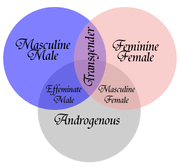
Gender identity disorder (GID)
(A problem, condition Eric Olafson has or had)
is the formal diagnosis used by psychologists and physicians to describe persons who experience significant gender dysphoria (discontent with the sex they were assigned at birth and/or the gender roles associated with that sex). It describes the symptoms related to transsexualism, as well as less severe manifestations of gender dysphoria. GID is classified as a medical disorder by the ICD-10 CM[1] and by the DSM-IV TR.[2] It is likely that the new version of the DSM will replace this category with "Gender Dysphoria."[3] Some authorities do not classify gender dysphoria as a mental illness, including the NHS which describes it as "a condition for which medical treatment is appropriate in some cases."[4]
Gender identity disorder in children is considered clinically distinct from GID that appears in adolescence or adulthood, which has been reported by some as intensifying over time.[5] As gender identity develops in children, so do sex-role stereotypes. Sex-role stereotypes are the beliefs, characteristics and behaviors of individual cultures that are deemed normal and appropriate for boys and girls to possess. These "norms" are influenced by family and friends, the mass-media, community and other socializing agents.[6] Since many cultures strongly disapprove of cross-gender behavior, it often results in significant problems for affected persons and those in close relationships with them. In many cases, transgender individuals report discomfort stemming from the feeling that their bodies are "wrong" or meant to be different.
Many transgender people and researchers support the declassification of GID as a mental disorder for several reasons. Recent medical research on the brain structures of transgender individuals have shown that some transgender individuals have the physical brain structures that resemble their desired sex even before hormone treatment.[7][8] In addition, recent studies are indicating more possible causes for gender dysphoria, stemming from genetic reasons and prenatal exposure to hormones, as well as other psychological and behavioral reasons. (See Causes of transsexualism).
One contemporary treatment for GID consists primarily of physical modifications to bring the body into harmony with one's perception of mental (psychological, emotional) gender identity, rather than vice versa.[9]